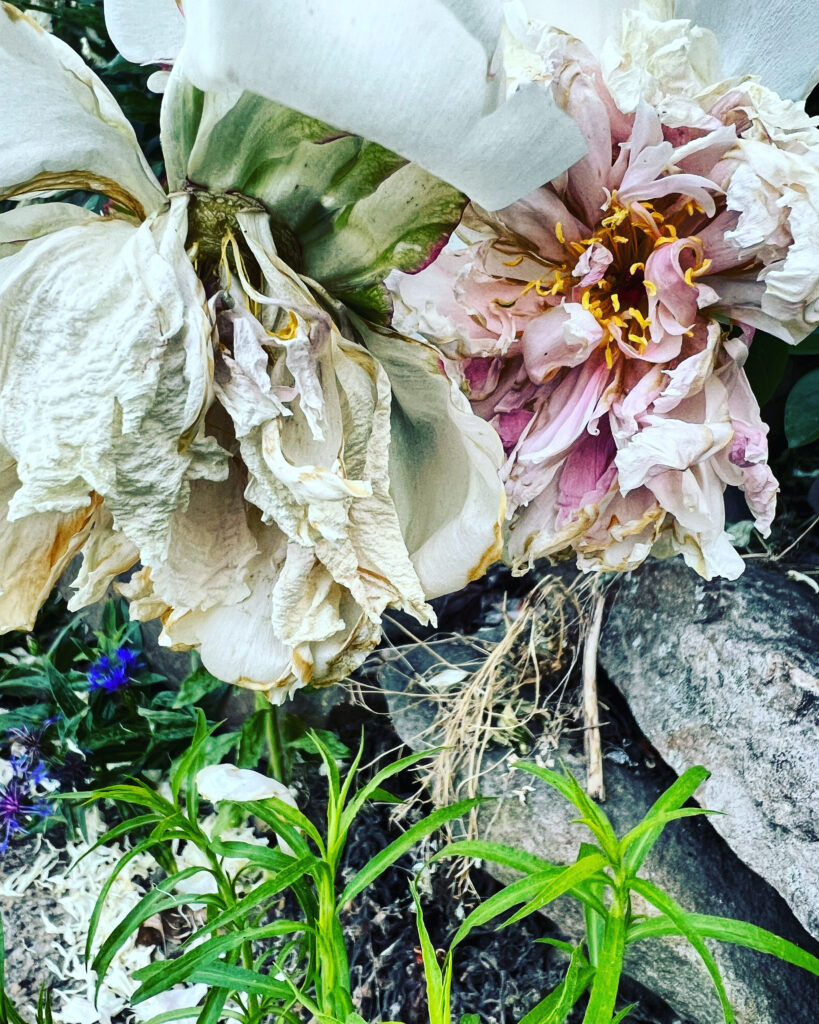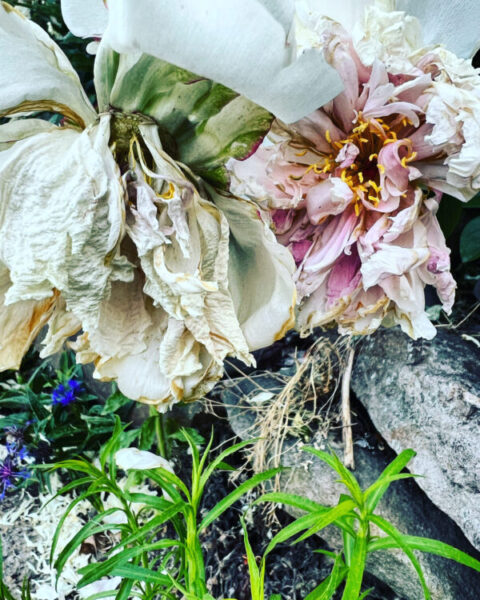It’s March-April-May-June, a tunnel of months in which a season rotates once then twice, and if I ignore the dictated terms of the calendar, other things alert me time has turned the topsoil. Subtle signs in the school world: my obstinate children are more averse than ever to showering because they insist they will get stinky all over again the next day with kickball rollerskating soccer swimming hiking climbing recess. End-of-year portfolios come home bursting with math papers evicted from the classrooms due to be gutted and cleaned over summer. Three garbage bags’ worth of fall/winter coats, water bottles, umbrellas, and folders get hauled out of the locker. Cafeteria school lunch menus lean listlessly toward leftovers: “chicken selections” and “pizza options.” I’m alerted to the school bus arriving home not by squealing brakes as through winter but because the bus windows are down (re: stinky bodies), and the sixth graders’ bus karaoke reaches my ears before the vehicle slows. “We Will Rock You” was a particularly popular (and loud) number this spring.
If school does not trigger a seismic heave toward summer, nature itself attacks in a short-lived fury of blossom. This spring I tracked daffodils, tulips, lupine, honeysuckle, azaleas, dogwoods, magnolias, rhododendron, and peonies. Each flower had a shape and color that insisted on being the miracle of the moment before running out of vital life force and succumbing in a crumpled husk of petals to fertilize the miracle stepping up next in line. No flower stayed as long as I would like. No spring day lingered to my satisfaction. June now. When half of the year lies behind me and in a few short weeks the days will be shortchanged of sunlight by a few more minutes with every passing 24 hours. School is out, and I do not wait at the bus stop for the singing return of my children, yet I daily visit my favorite patch of peonies in my neighbor’s front yard. I stand in the graveyard of diminished blooms and fight an embarrassing urge to yell at the devastated petals for giving up on life so easily, so soon. Poor peonies. What more could they have done, being a thing of nature sucked in the vortex of spring to summer?

In the myth of Persephone, when Persephone is incarcerated in the Underworld, the world mourns in winter garb with her mother, Demeter. When Persephone is released for a stint of freedom and reunited with Demeter, the world rejoices in spring and summer. Upon casual observance of this myth, I thought the emotions were as simple as a coin flicked, caught, and slapped upside down on a hand: heads or tails. Happy or sad.
But my own experience of March-April-May-June with its signature “chicken selections” and peonies makes me wonder if there ever was a heads or tails for Demeter? Was her “happy” ever purely “happy”? All too soon, the peonies of her days with Persephone would have dried, shriveled, and blown away in a hot July breeze. Even the season of Demeter’s greatest delight would remind her nothing stays as long as forever. The world is on a shuddering start toward an eternity of perfection. Even as the red cup of a tulip petal falls holding the gold dust of pollen against the creamy oval once attached to the stem, the petal fulfills a purpose: it is a sign, a promise pointing to greater things to come. Next spring, new tulips. When Jesus performed miracles, John, one of his closest friends and a deeply thoughtful writer, refused to use the word “miracle” to describe the disruptive ways Jesus of Nazareth intervened in human lives, expectations, and calendars. John described the disruptions by insisting on calling them “signs.” He never wrote the word “miracle.” Jesus’ interventions—miraculous things certainly—weren’t meant to be aberrations but promises or signs pointing to greater, mind-blowing things that would come and yes, on that unpredicted future date, stay. Next spring, new life.
Persephone set foot above ground every six months. To the Greeks, who couldn’t have a calendar printed and shipped to their houses in the year of our Lord whatever BC they were in, Persephone was their sign as predictive as my calendar flipping pages. Today’s beauty points forward at awe to come in the calendar box we call “tomorrow.” I am an observant mourner, whether I mourn Persephone disappearing back underground when her footsteps are traced with frost, or I mourn a body hanging on a cross designated by a very different sort of sign: “King of the Jews.” Spring comes and goes, and I cannot will the petals to hold fast the peonies nearly as long as I would like. But each May the peonies reappear, a sign to shock me afresh: such exquisite beauty is stubbornly, repeatedly possible.
It will rock you, this annual, average, expected, miraculous beauty, and if I wait for enough calendar pages to turn, a year will revolve, school will come and then prepare to go, the daffodils will spear through stubborn March soil to unfurl yellow trumpets heralding spring, peonies will briefly reign, and all that I thought lost, buried, and mourned will be resurrected.


So beautiful and well written. You do such an amazing job of connecting pieces together. It is a joy to read everything you write.